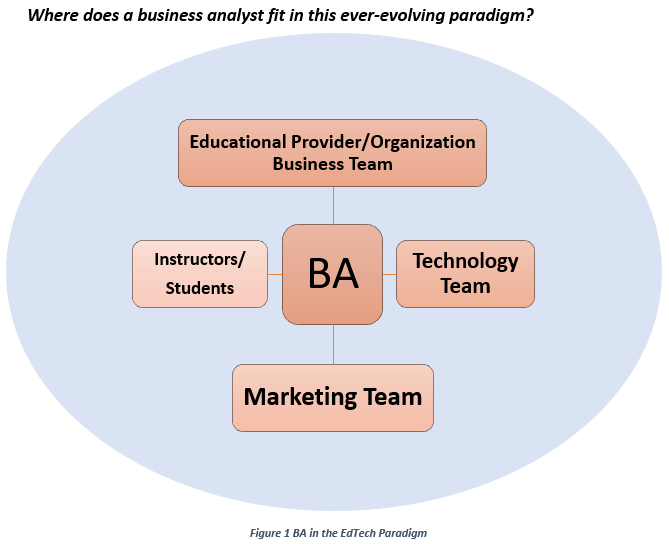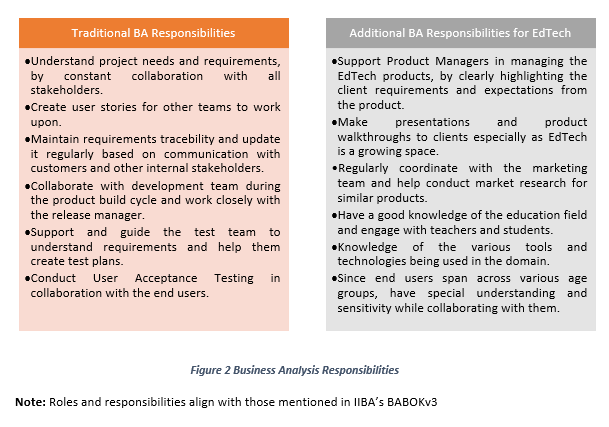How a Business Analyst can add value to an Education Technology Organization
We are currently amid a technology revolution in the field of education.
It is such an important new era where the amalgamation of technology and education has grown exponentially, especially in the last year as we deal with Covid19. While educational institutions are spending more and more on Education Technology products, the goal remains the same- to enhance and enrich the learning experience. EdTech, the more widely used acronym for education technology, encompasses the use of various technologies for imparting knowledge. Over the past few years several technology firms have ventured in this field, targeting mainly the space of digital training for employees, adult students, and professionals. These were mainly individuals who wanted to give their careers an edge in the competitive environment.
With a pandemic changing the dynamics of education, EdTech has become an essential for each household across the world. Now, not only adults but children at all levels of education, not just limited to K-12, need various tools and products to learn and grow every day.
This has not only given the spotlight to the technology companies but also given a new dimension to the role of Business Analyst (BA), who usually perform a wide range of activities. It is a role where one’s perception cannot be tied to a particular domain. Business Analysts gladly wear multiple hats, and several times land up in the eye of the storm. In terms of the EdTech field, a business analyst is once again as much aligned to the business teams in an organization as they are aligned to the technology teams.

There are a few points that need to be kept in mind when we look at the above diagram. They are as below:
- How BA aligns with the Business team?
A BA with strong analytical and communication skills, aligns with the Business team to understand the main motivation behind the project. In more technical terms, we refer to them as someone who translates business needs into operational requirements. They also document and maintain business rules. In the EdTech environment, the business team stakeholders can be the university or school board members, department heads, or even startup founders.
- How BA aligns with the Technology team?
This is an important aspect of the roles and duties of a BA. They not only define, organize, maintain, and deliver functional and data requirements, but also use the business and product requirements to help build out technical specifications. They collaborate with various members of the technical teams like product owners, designers, developers, QA teams, and product release teams. Each of these stakeholders need the business analyst for not only defining the user stories, but also providing a dynamic perspective to the ever-changing requirements.
- How BA aligns with the End-Users?
A BA not only helps to define the user’s needs, but also recommends solutions to fulfil the user-centered goals. They actively engage with teachers and students to develop requirements, carefully assessing their needs and challenges. User acceptance testing is an important task of a BA.
- How BA aligns with the Marketing team?
In collaboration with the sales and marketing teams, a BA, actively participates in the building of a product marketing plan to not only support the commercialization and product placement plan, but also align it to the needs of the customer and help identifying the target market.
Traditional Business Role Vs Diverse Business Analysis Role
EdTech companies are always on the lookout for Business Analysts to grow their technology teams. These companies are constantly creating new EdTech products thus, require motivated teams to work on those. Traditionally, Business Analysts have a set number of tasks they used to handle on a day-to-day basis. But nowadays, the role has evolved into something bigger. When we look at the new industries, making use of emerging technologies, for example, in the space of education technology, the role of a business analyst has newer responsibilities in addition to the traditional ones. The interesting thing about this phenomenon is some of these responsibilities or tasks were earlier handled by other roles, but now have seamlessly merged into this one role.

Business Analysis – Revolutionizing Diverse EdTech Domain Spectrums
As mentioned earlier, traditional business analysis roles have had specific set of responsibilities as defined above, in Figure 2. But nowadays, there are several roles that have evolved from the original one, making business analysis more and more dynamic than ever before and more conducive to the everyday demands of rapidly progressive industries like EdTech.
Business Intelligence Analyst aligns and collaborates with various analytics to present customizable data for business teams. In addition, this role is vital in helping everyone in the project team to understand their data needs and collaborate with different divisions within the organization, providing them with data solutions.
Business Operations Analyst is another data centric role, mostly responsible for ensuring organization’s data integrity and use the internal data to track the progress and drawbacks in the day to day functioning of the organization. They collaborate with Data teams for development of various reporting tools that help the organization draw blueprints for overall success and growth.
Enterprise Business Analyst collaborates with stakeholders in enterprise sales as well as account management. They also work closely with customer teams to ensure there are no gaps in the relationship between the organization and their clients.
Looking at the various ways a business analyst can contribute to the success of an EdTech organization, it is imperative for organizations to utilize their valuable inputs and use their knowledge to optimum potential.













